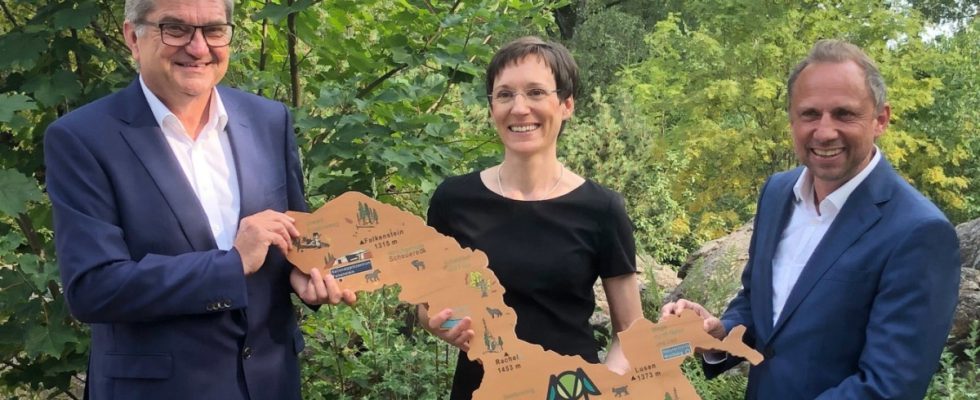The biologist and outgoing head of the Bavarian Forest National Park, Franz Leibl, has certainly rendered many services to Germany’s oldest and most renowned national park. His greatest achievement is that the Waidler, as the locals in the Bavarian Forest confidently call themselves, have not only reconciled themselves to it after decades of dispute over the large nature reserve. Instead, they have long shown a certain pride in the national park and – at least sometimes – even call it “our national park”. It was very nice to see this on Tuesday in the National Park Center in Neuschönau during the official farewell to Leibl, who is retiring on August 1 after twelve years at the head of the protected area.
When Leibl had finished his farewell speech, it was quiet for a moment among the mostly male guests at the reception. Then it went like a jolt through the mayors and district administrators, the heads of authorities, association people and ministerials. One after the other got up from their seats. And then the Leibl party gave standing applause for several minutes. He was standing in front of the stage and gave the impression that he didn’t really know what to do with it. It must have pleased him, of course. Such a scene would have been unthinkable when Leibl’s predecessors, Hans Bibelriether and Karl-Friedrich Sinner, said their farewells, as controversial as the national park was in both terms of office.
Primeval spruce and beech forests, streams with crystal-clear water, enchanted high moors and magnificent flower meadows, plus primeval forests such as the Höllbachgespreng or Mittelsteighütte – the Bavarian Forest National Park is the epitome of intact nature. That’s the page. The other was for many decades gigantic areas full of gray dead trees on the Rachel and Lusen, where the bark beetle attacked the former old spruce forests. Because unlike in ordinary forests, the forest in a national park is left to its own devices – even when storms hit it, thousands upon thousands of trees are knocked down and pests attack them. The long dying of the former old forest has long since been followed by the birth of a young, vigorous and extremely species-rich young one.
“trick, camouflage, deceive”
Many, especially older locals in the Bavarian Forest were horrified by the death of the old forests. That’s why they couldn’t and didn’t want to become friends with the national park. For a long time, the mayors and local councils in the communities around the national park were also unwilling to accept that new zones were being set up there in which only nature was at work. It was less than ten years ago that the then district administrator of the Regen district, Michael Adam (SPD), tackled Leibl hard because of the expansion of strict nature protection in the north of the protected area. In e-mails and letters he accused Leibl of “tricks, camouflage, deception” and denounced “semi-official backroom rounds”. But unlike in comparable fights before, this time the resistance has crumbled, so to speak.
The reason: Leibl is from Lower Bavaria. Although he is not a Waidler, he comes from Straubing. He knows the type of people in the Bavarian Forest through and through – and he understands them. He speaks the same language and is a very careful listener, even if he comes across as a little grumpy at times. Leibl was always ready and will be until his last day of work on July 30th to explain and describe everything he does in the national park. And as often as is necessary. Even the toughest critics of the protected area quickly recognized and honored this. Gerti Menigat, the former mayor of the small municipality of Lindberg, which borders directly on the national park, is a good example of this. For a long time she has made no secret of the fact that she rejects the national park. Soon after Leibl took office, she said: “Leibl helps us locals a lot, he takes our concerns seriously. His ideas make sense.”
The Finsterauer Filz is a natural jewel in the expansion area of the Bavarian Forest National Park near the village of Mauth.
(Photo: Karl Klostermann/NP Bavarian Forest)
It is above all thanks to Leibl that the latest major project in the national park not only went smoothly, but also without any protest or objection, as Environment Minister Thorsten Faithr emphasized in his laudatory speech on Tuesday. On the 50th anniversary of the national park three years ago, Prime Minister Markus Söder extended the protected area by around 700 hectares to the east near the village of Mauth. The only condition was that the expansion was desired in the region. Of course, fears and concerns immediately boiled up – especially among older Mauthers. Leibl, born in 1957, not only made sure that they didn’t overcook. He has also had his term of office extended beyond the retirement limit so that he can wrap up the expansion.
Ursula Schuster Leibl succeeds him on August 1st. The 47-year-old landscape ecologist has completed a classic state career – at the Bavarian Academy for Nature Conservation and Landscape Management in Laufen, Upper Bavaria, in the Ministry of the Environment and in the State Chancellery. In the Ministry of the Environment, she was responsible, among other things, for planning a third national park in Bavaria, which the then Prime Minister Horst Seehofer wanted to set up in 2016 and 2017, but which failed due to the strong resistance of the population in the selected regions. Most recently, she headed the office of one of the two heads of department in the Ministry of the Environment. As far as running the national park is concerned, Schuster has a great head start. She was born in Passau and for that reason alone she has had close ties to the Bavarian Forest since she was a child.

